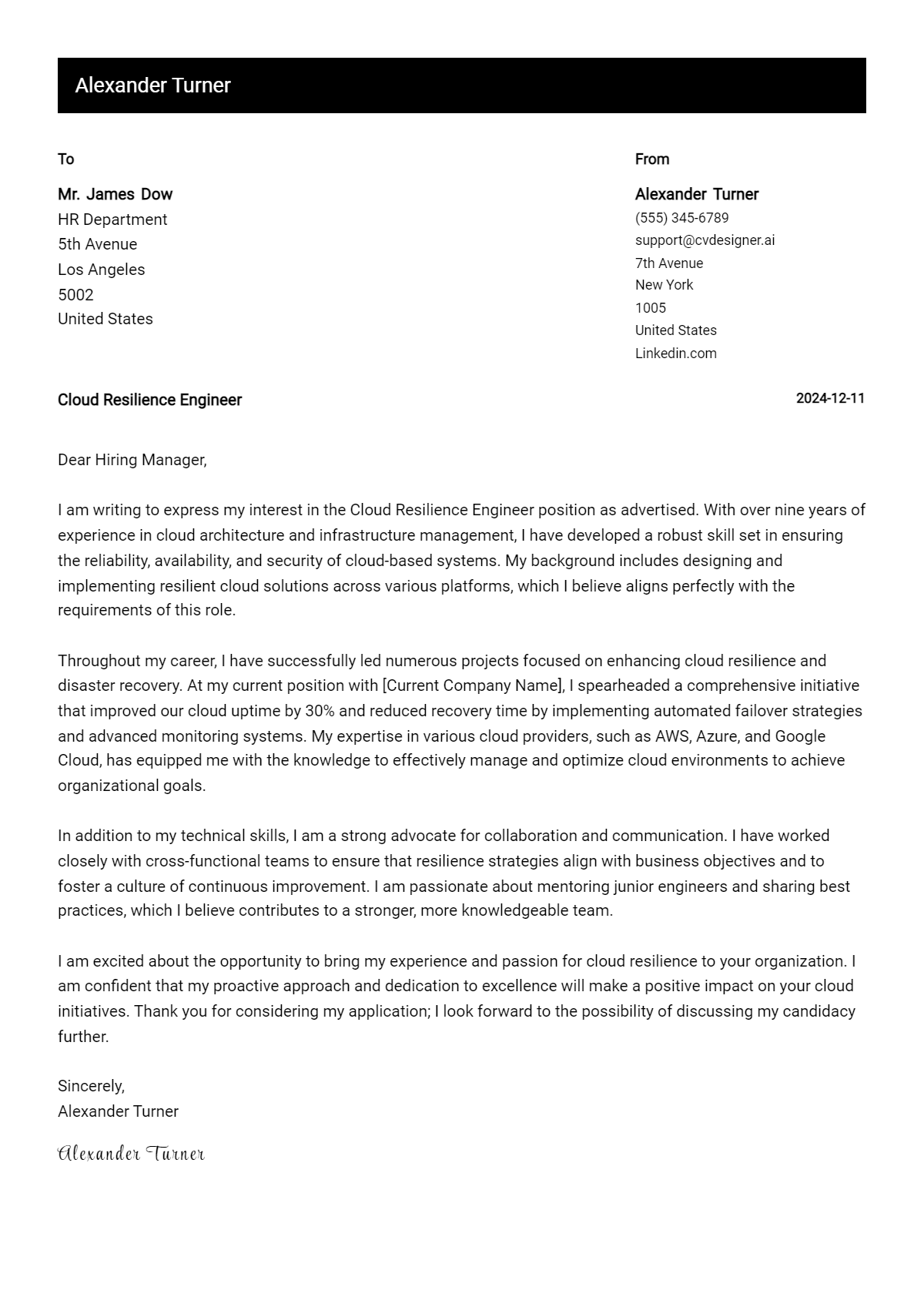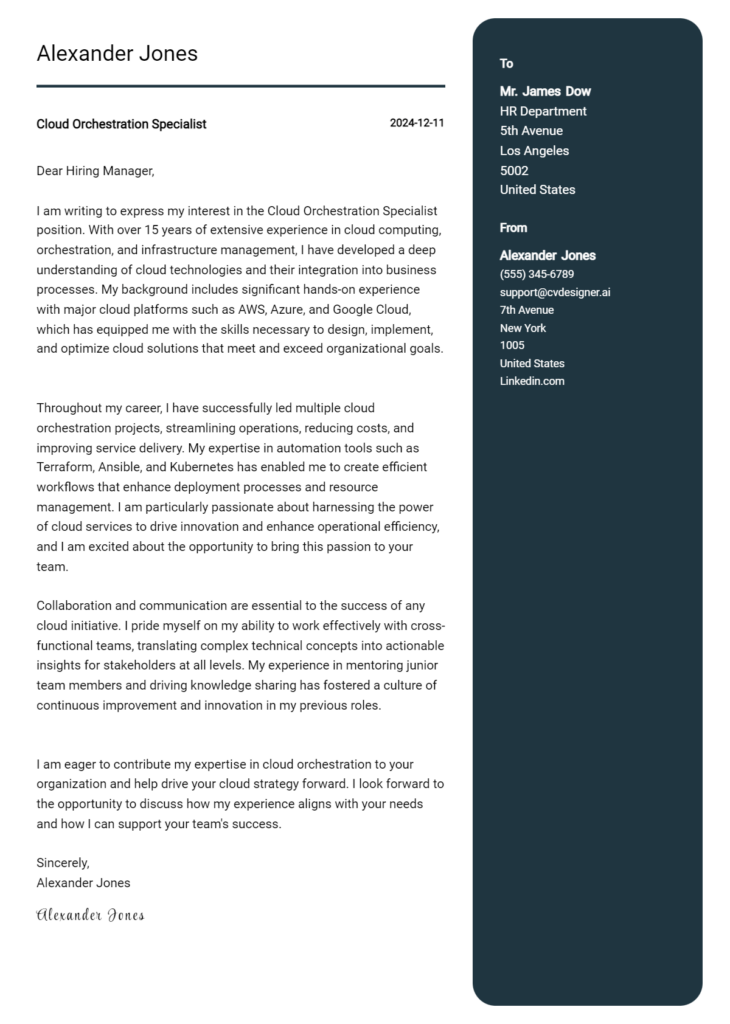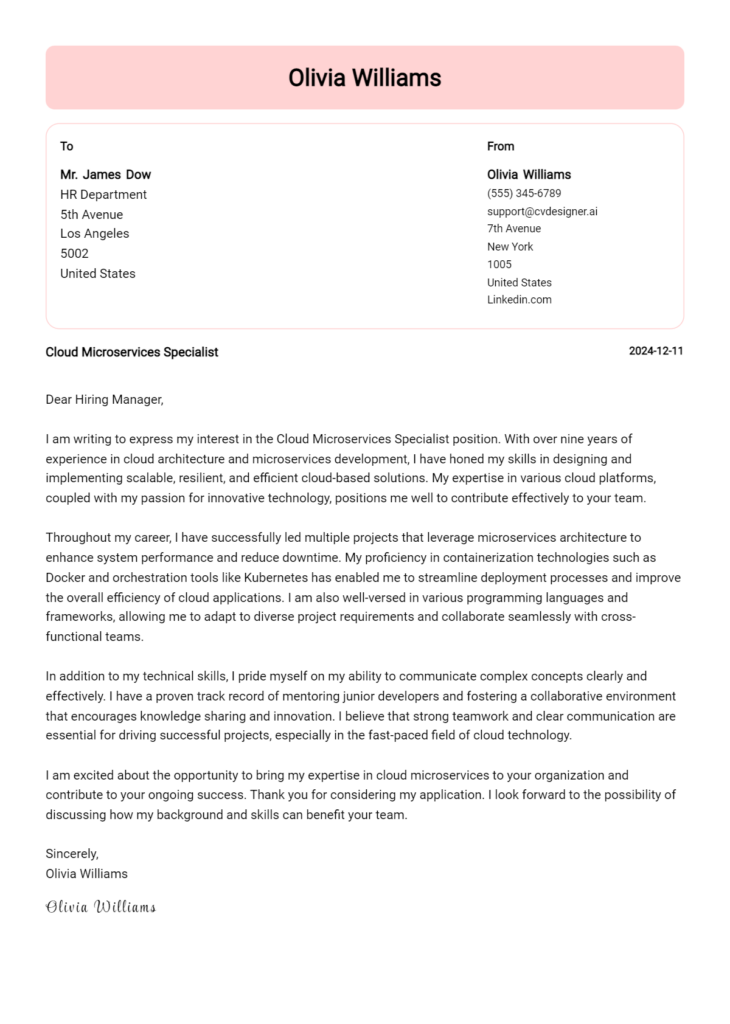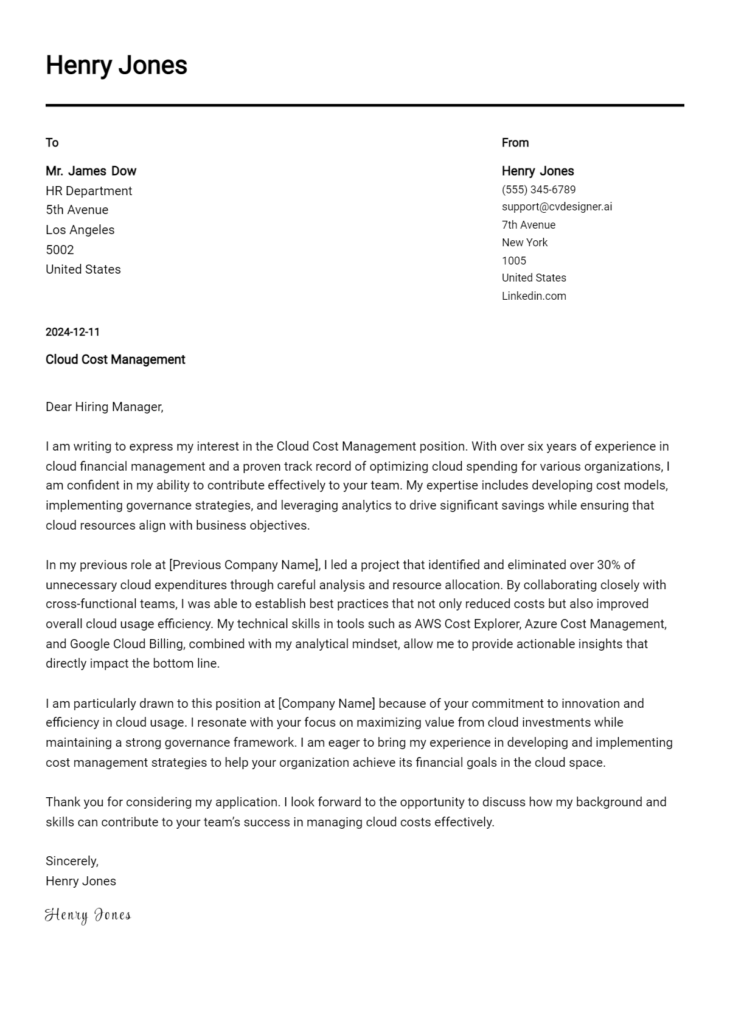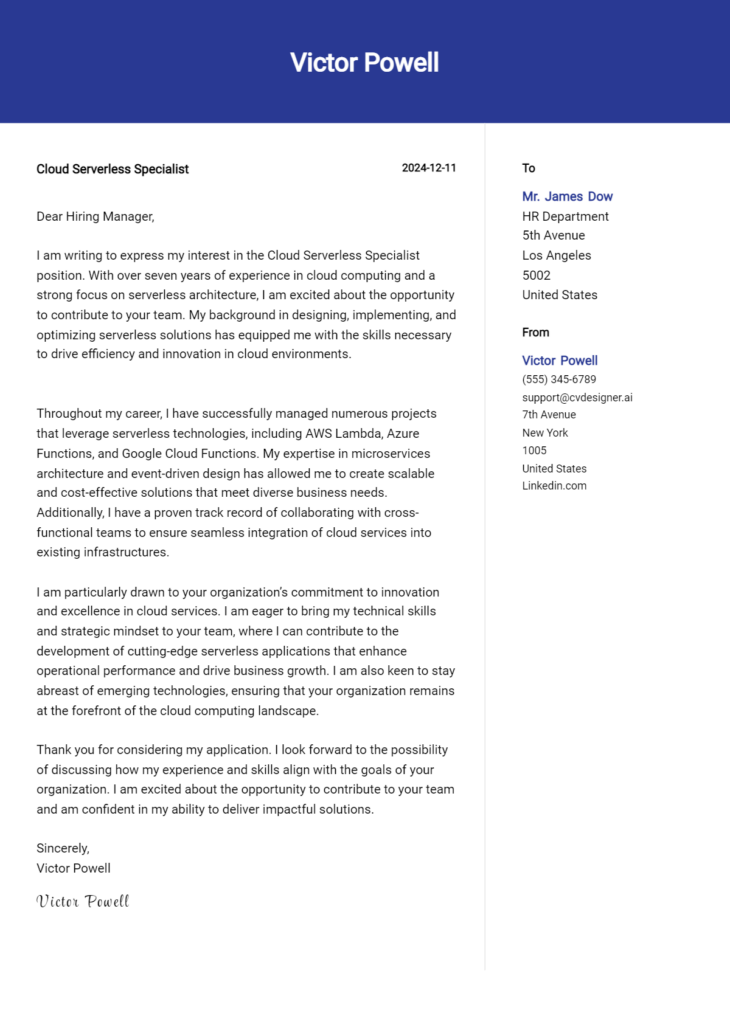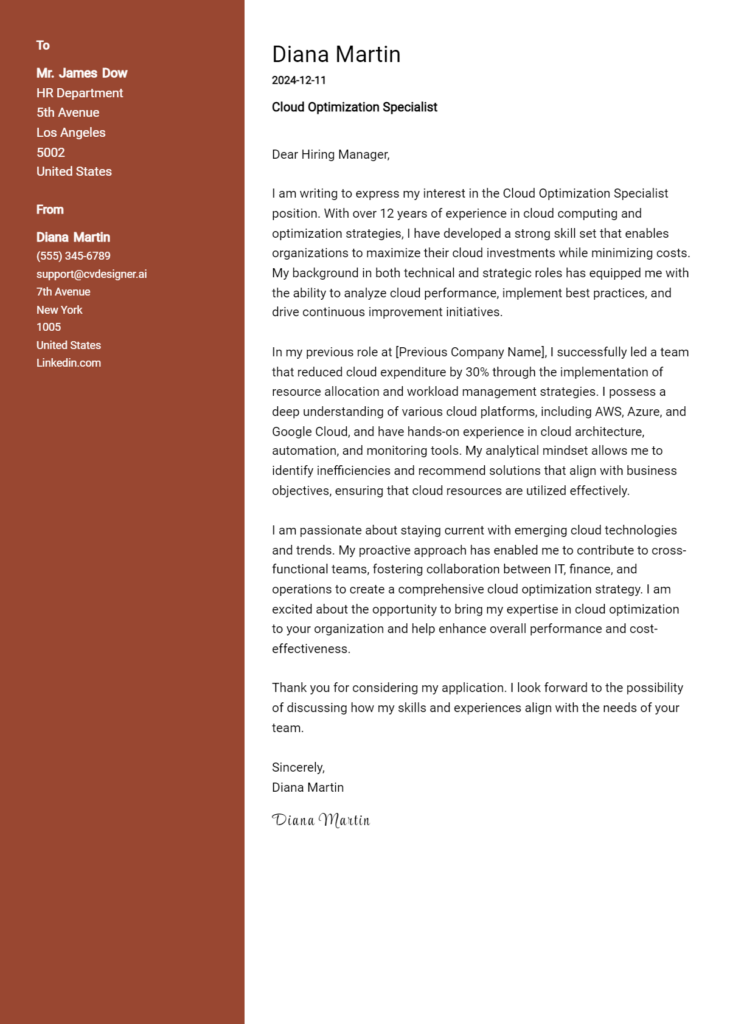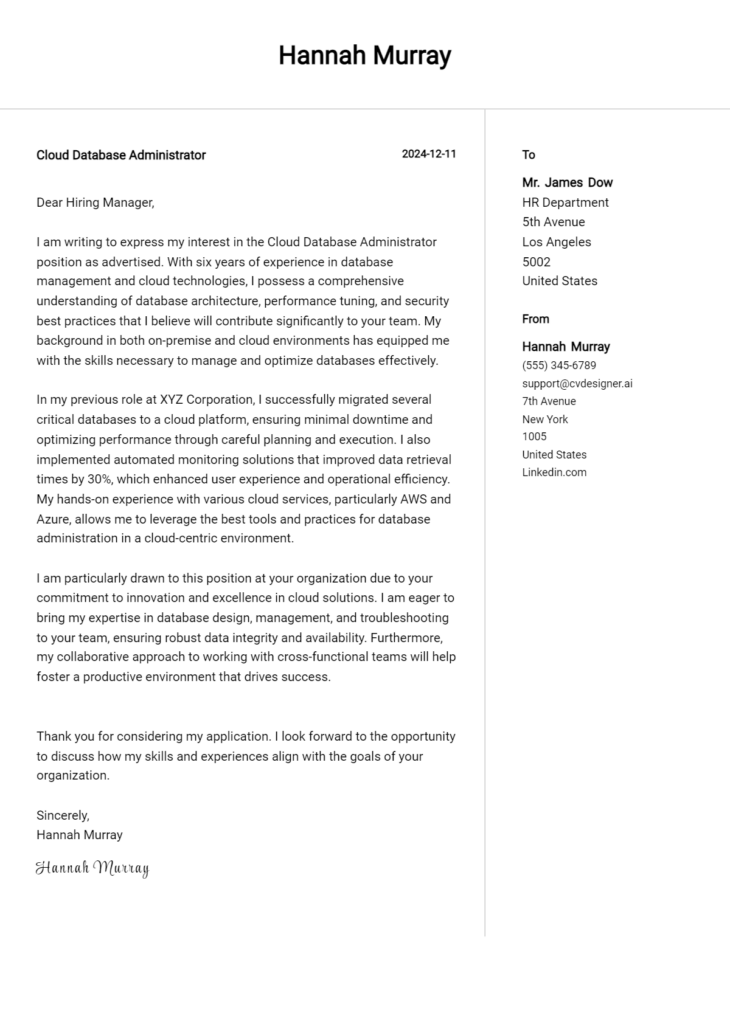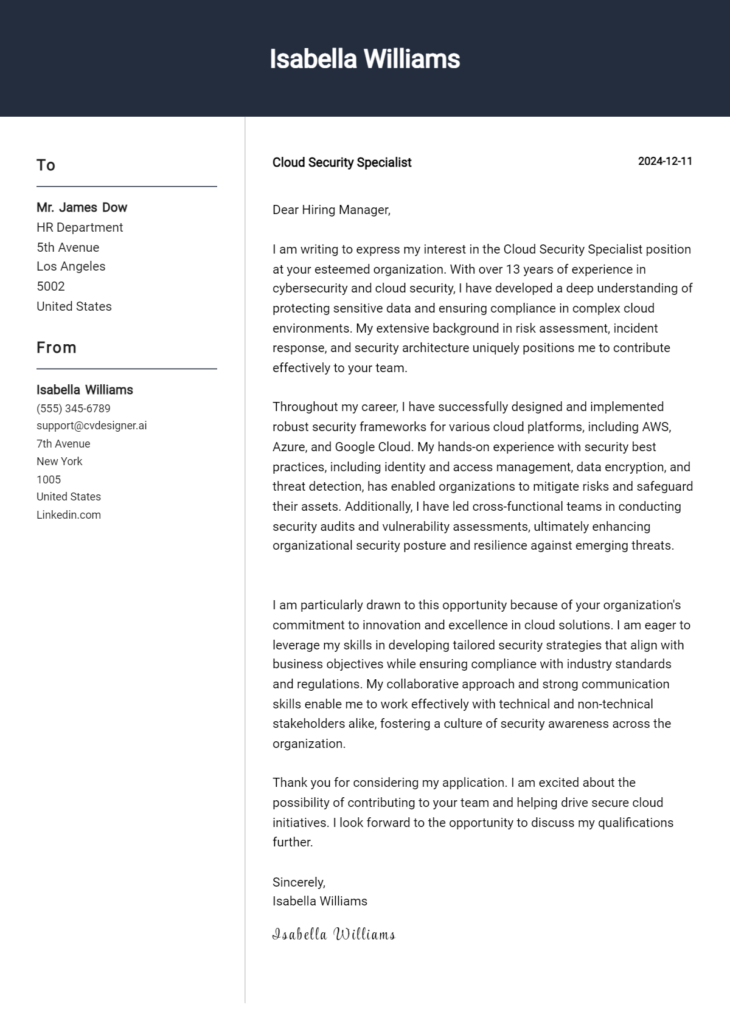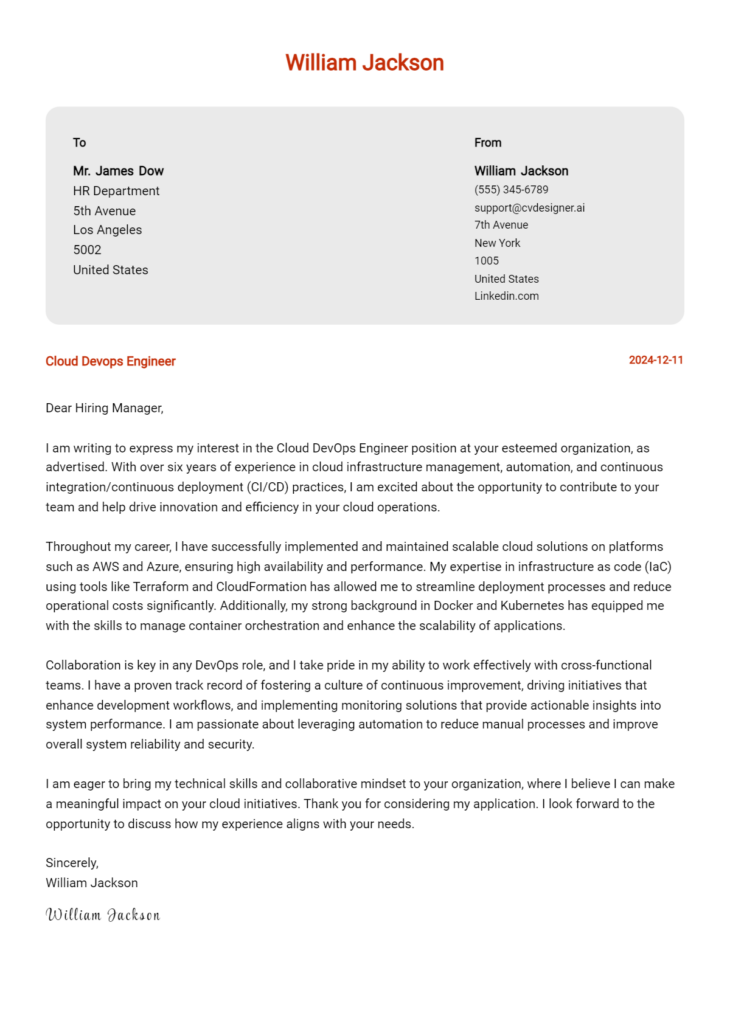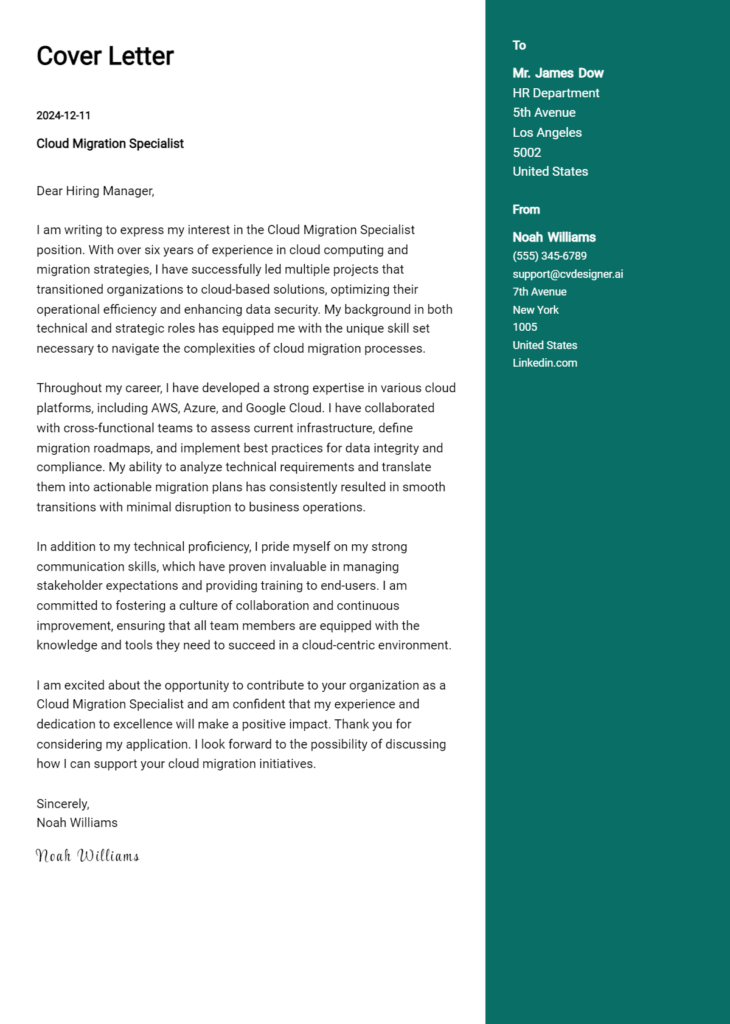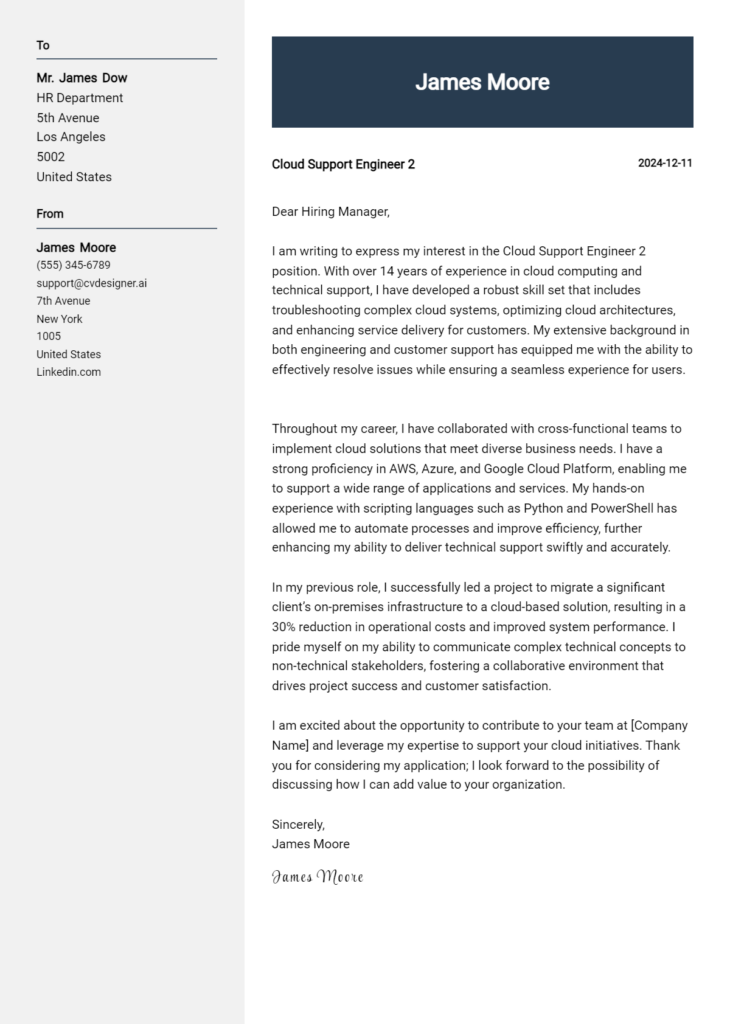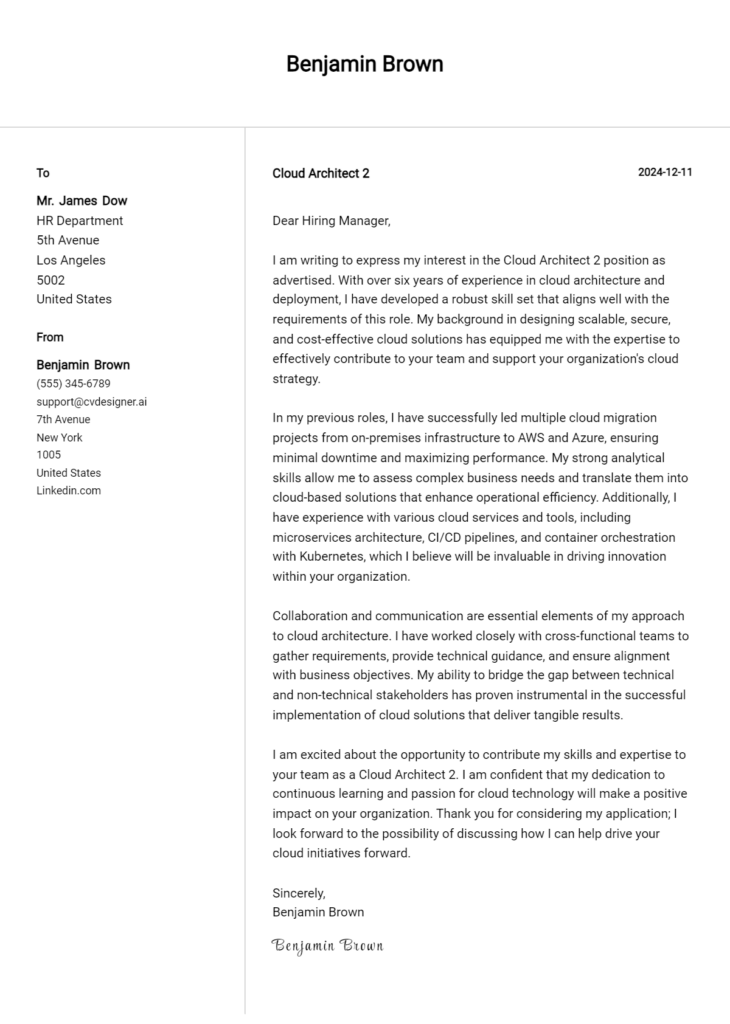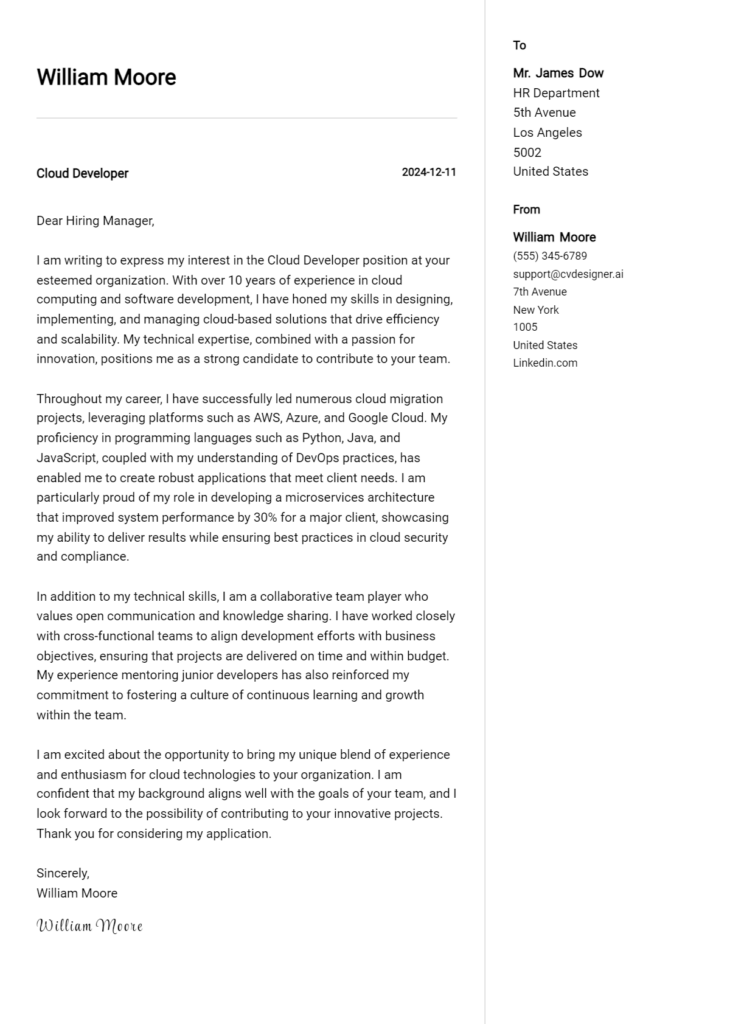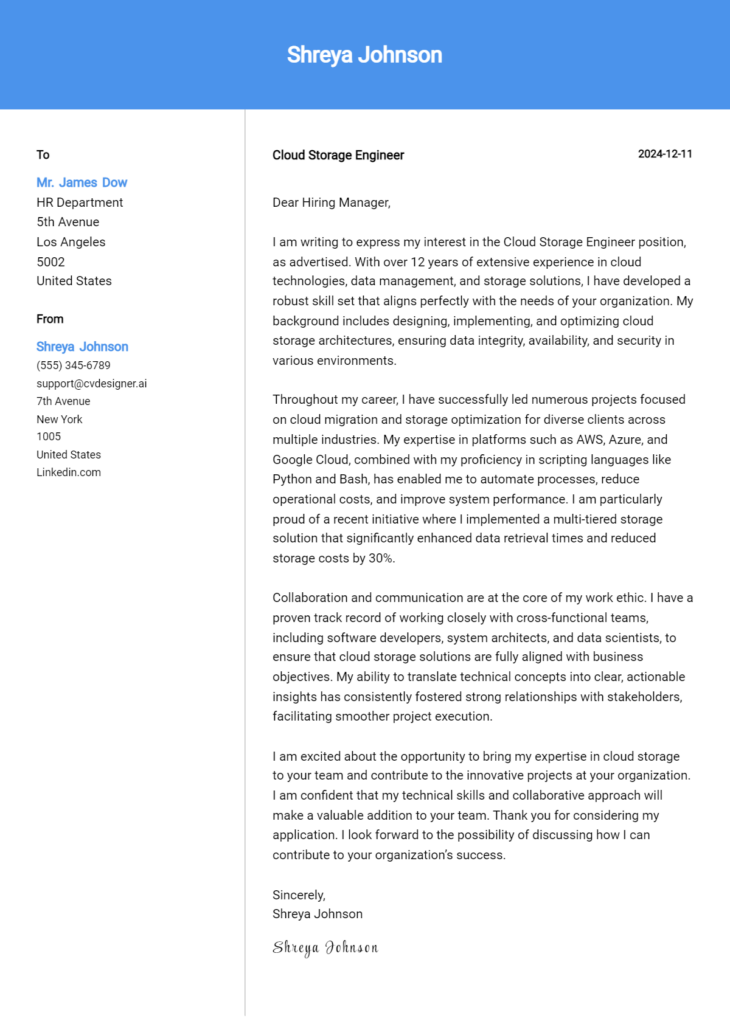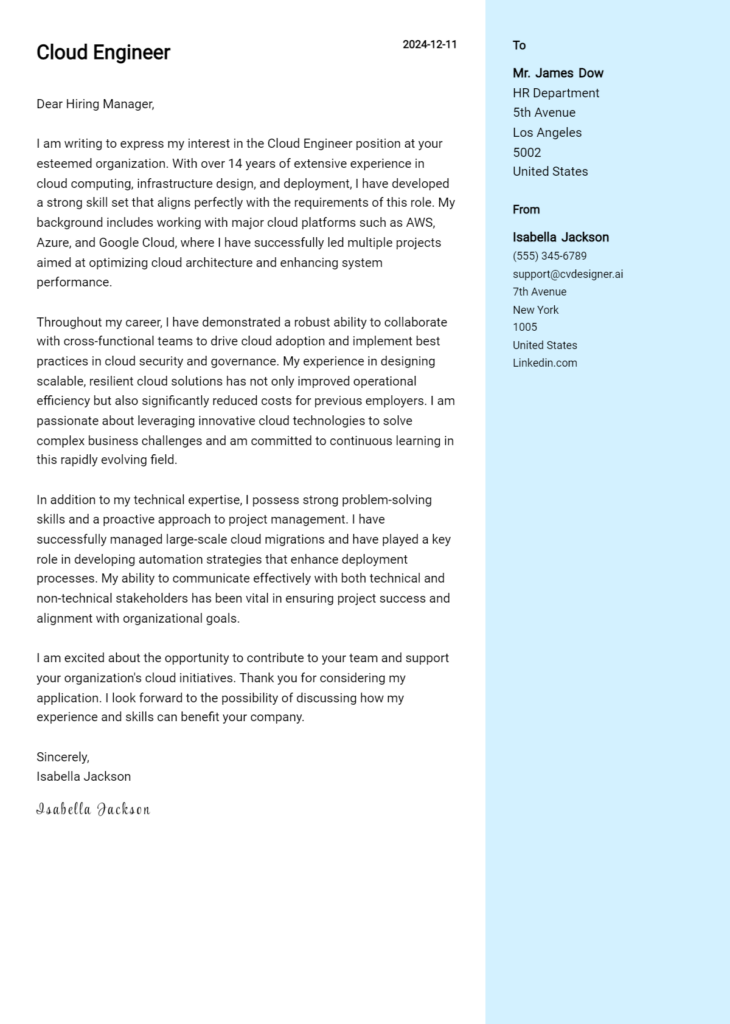Cloud Resilience Engineer Cover Letter Examples
Explore additional Cloud Resilience Engineer cover letter samples and guides and see what works for your level of experience or role.
How to Format a Cloud Resilience Engineer Cover Letter?
Crafting a compelling cover letter is essential for a Cloud Resilience Engineer, as it serves as your first opportunity to make a strong impression on potential employers. The way you format your cover letter not only reflects your technical skills and qualifications but also demonstrates your ability to communicate effectively and organize information clearly—critical attributes in the field of cloud engineering. A well-structured cover letter can effectively highlight your problem-solving abilities and proactive approach, both of which are vital for ensuring cloud resilience.
In this guide, we'll outline the key components of a professional cover letter, providing insights and examples tailored specifically for Cloud Resilience Engineers.
We'll focus on the essential elements of a standout cover letter, including:
- Cover Letter Header
- Cover Letter Greeting
- Cover Letter Introduction
- Cover Letter Body
- Cover Letter Closing
Each section is crucial in showcasing your expertise and professionalism. Let’s dive into each part and explore how to make your Cloud Resilience Engineer cover letter shine.
Importance of the Cover Letter Header for a Cloud Resilience Engineer
The cover letter header is a critical component of any job application, including for a Cloud Resilience Engineer position. It serves as the first impression for potential employers and sets the tone for the rest of your application. A well-organized header should include your contact information, the date, and the recipient's details, ensuring clarity and professionalism. This information allows hiring managers to easily identify who the application is from and how to reach out. A strong header conveys attention to detail and respect for the hiring process, which are essential traits for a role that focuses on maintaining and improving cloud infrastructure resilience.
Strong Example:
John Doe 123 Cloud Lane Tech City, CA 12345 john.doe@email.com (123) 456-7890 October 1, 2023 Jane Smith Hiring Manager Cloud Innovations Inc. 456 Tech Ave Innovation City, CA 67890
Weak Example:
Hey, This is John. 10/1/23 To whom it may concern,
The Importance of the Cover Letter Greeting
The greeting in a cover letter serves as the first point of contact with the hiring manager and sets the tone for the rest of the letter. A well-crafted greeting demonstrates professionalism, respect, and a personal touch, which can significantly influence the reader's perception of the applicant. By addressing the hiring manager directly, the candidate shows that they have taken the time to research and personalize their application, distinguishing themselves from other applicants who may opt for generic salutations. To create a strong impression, it’s advisable to avoid generic greetings like "To Whom It May Concern" or "Dear Hiring Manager." Instead, invest time in finding the recipient's name through company websites, LinkedIn, or networking contacts, if necessary.
Strong Greeting Example
Dear [Hiring Manager's Name],
Weak Greeting Example
To Whom It May Concern,
The Importance of a Well-Crafted Cover Letter Introduction for a Cloud Resilience Engineer
The cover letter introduction is a critical component of your application as a Cloud Resilience Engineer. It serves not only to capture the hiring manager's attention but also to express your enthusiasm for the role and provide a glimpse of your qualifications. A strong introduction will set the tone for the rest of your letter, showcasing your relevant skills and achievements in a compelling manner. Conversely, a weak introduction may fail to engage the reader, risking your chances of making a positive impression. Below are examples that illustrate the difference between a strong and weak cover letter introduction.
Strong Example
Dear [Hiring Manager's Name], As a dedicated Cloud Resilience Engineer with over five years of experience in designing and implementing robust cloud strategies, I was excited to find the opening at [Company Name]. My background in disaster recovery planning and my proven track record of reducing downtime by 30% in previous roles position me uniquely to contribute to your team. I am passionate about leveraging innovative solutions to ensure business continuity and resilience, aligning perfectly with [Company Name]'s commitment to operational excellence.
Weak Example
To Whom It May Concern, I am applying for the Cloud Resilience Engineer position. I have some experience with cloud systems and think it would be a good job for me. I hope you consider my application.
Purpose of the Cover Letter Body for a Cloud Resilience Engineer
The cover letter body for a Cloud Resilience Engineer serves as a vital component of the job application, allowing candidates to effectively showcase their technical skills, relevant experiences, and the unique value they can bring to the organization. This section should highlight specific projects or accomplishments that demonstrate the candidate's expertise in cloud infrastructure, disaster recovery, and resilience strategies. By providing concrete examples, the candidate can create a compelling narrative that aligns their background with the job requirements, ultimately persuading the hiring manager of their suitability for the role.
Strong Example
Dear [Hiring Manager's Name], I am excited to apply for the Cloud Resilience Engineer position at [Company Name]. In my previous role at [Previous Company], I successfully led a project that implemented a multi-cloud disaster recovery solution, reducing system downtime by 40%. By leveraging tools such as AWS CloudFormation and Terraform, I streamlined our infrastructure deployment, which enhanced our ability to recover from outages. Additionally, my collaboration with cross-functional teams resulted in a comprehensive resilience strategy that not only safeguarded critical data but also improved overall operational efficiency. I am eager to bring my expertise in cloud architecture and my passion for innovative solutions to [Company Name]. Best regards, [Your Name]
Weak Example
Dear [Hiring Manager's Name], I want to apply for the Cloud Resilience Engineer position at [Company Name]. I have worked with cloud technologies before and know a bit about disaster recovery. I think I could be a good fit for the job. I have done some projects but they were not very complex. I hope you consider my application. Sincerely, [Your Name]
Importance of the Cover Letter Closing for a Cloud Resilience Engineer
The closing paragraph of a cover letter is crucial, as it encapsulates your qualifications and reinforces your enthusiasm for the Cloud Resilience Engineer position. This section should summarize your key skills, express your keen interest in the role, and encourage the hiring manager to take the next step, such as reviewing your resume or scheduling an interview. A strong closing leaves a lasting impression and enhances your chances of progressing in the hiring process, while a weak closing may undermine your overall application.
Strong Example
Thank you for considering my application for the Cloud Resilience Engineer position. With my extensive experience in cloud architecture and disaster recovery strategies, I am excited about the opportunity to contribute to your team. I am particularly drawn to your commitment to innovation and excellence in cloud solutions. I look forward to the chance to discuss how my skills align with your needs. Please feel free to review my resume, and I would be thrilled to schedule an interview at your convenience.
Weak Example
I think I might be a good fit for this job. I have some experience in cloud engineering. Let me know if you want to talk more about it. My resume is attached.
These tips are designed to assist candidates in crafting an effective cover letter for the role of a Cloud Resilience Engineer. In this highly technical field, it is crucial to highlight not only your technical skills but also your problem-solving abilities, understanding of the Software Development Life Cycle (SDLC), teamwork experience, and a strong passion for continuous learning. A well-crafted cover letter can set you apart from other candidates and showcase your unique qualifications for this important role.
Cover Letter Writing Tips for Cloud Resilience Engineer
Highlight Technical Skills: Clearly outline your proficiency in cloud platforms (such as AWS, Azure, or Google Cloud), infrastructure as code (IaC) tools, and containerization technologies. Use specific examples to demonstrate how you've applied these skills in previous projects. This not only shows your technical expertise but also your ability to implement resilient cloud solutions.
Showcase Problem-Solving Abilities: Provide examples of challenges you have faced in cloud environments and how you successfully resolved them. Describe the methodologies you used, such as root cause analysis or incident response strategies, to emphasize your analytical thinking and ability to maintain uptime and reliability.
Demonstrate SDLC Knowledge: Mention your experience with the Software Development Life Cycle and how you have integrated resilience practices into each phase of development. Discuss your familiarity with agile methodologies and how they contribute to delivering robust applications in the cloud.
Emphasize Teamwork and Collaboration: Cloud resilience engineering often involves working with cross-functional teams. Highlight your experience in collaborating with developers, operations, and security teams to create a seamless cloud ecosystem. Use anecdotes that illustrate your ability to foster teamwork and solve problems collectively.
Express Passion for Continuous Learning: The cloud landscape is ever-evolving, so it's essential to convey your commitment to professional development. Mention any relevant certifications, workshops, or courses you have pursued to stay updated on the latest technologies and best practices in cloud resilience. This demonstrates your proactive approach and dedication to excellence in your field.
For more resources, consider utilizing cover letter templates and a cover letter builder to create a polished and professional cover letter that showcases your qualifications effectively.
Common Mistakes to Avoid in a Cloud Resilience Engineer Cover Letter
Crafting a compelling cover letter is essential for landing a position as a Cloud Resilience Engineer. Avoiding common mistakes can significantly enhance your chances of making a positive impression. Here are some common pitfalls to watch out for and tips on how to steer clear of them:
Generic Language: Using vague phrases can make your cover letter feel impersonal. Tailor your letter to reflect the specific job and company by mentioning their key projects or values.
Neglecting Formatting: Poor formatting can detract from your message. Adhere to proper cover letter format to ensure clarity and professionalism.
Focusing on Responsibilities Instead of Achievements: Instead of listing duties from previous roles, highlight your accomplishments. Use metrics to showcase your contributions to cloud resilience initiatives.
Lack of Technical Detail: As a Cloud Resilience Engineer, you should demonstrate your technical expertise. Include relevant skills or tools, such as disaster recovery plans or cloud architecture frameworks.
Overlooking the Company Culture: Failing to align your values with the company's culture can weaken your application. Research the organization's mission and incorporate how your approach to cloud resilience fits within it.
Using Clichés: Phrases like "hardworking" or "team player" can come off as insincere. Instead, provide specific examples of how you've successfully collaborated with teams or solved problems.
Ignoring Call to Action: A cover letter should encourage the next step. Conclude with a proactive statement expressing your desire to discuss your qualifications further.
By steering clear of these common mistakes and focusing on crafting a personalized and well-structured letter, you can improve your chances of standing out as a qualified candidate. For further inspiration, check out various cover letter examples to see how others have successfully approached their applications.
Cover Letter FAQs for Cloud Resilience Engineer
What should I include in my cover letter for a Cloud Resilience Engineer position?
In your cover letter, focus on your technical expertise and experience with cloud architectures, disaster recovery, and resilience strategies. Highlight specific projects where you enhanced system reliability or managed cloud migrations. Mention relevant certifications, such as AWS Certified Solutions Architect or Microsoft Azure certifications, to demonstrate your qualifications. Additionally, emphasize your problem-solving skills and ability to work under pressure, as these are crucial in maintaining cloud resilience. Tailor your letter to the specific job description by using keywords from the posting, showing that you understand the role and its requirements.
How can I demonstrate my technical skills in the cover letter?
You can effectively demonstrate your technical skills by providing concrete examples of past projects or tasks that are relevant to the role of a Cloud Resilience Engineer. For instance, describe a situation where you implemented a backup and recovery plan that minimized downtime during a system failure. Use metrics to quantify your achievements, such as reduced recovery time or improved uptime percentages. Additionally, mention the specific tools, technologies, or frameworks you used, such as Kubernetes, Terraform, or AWS CloudFormation. This not only showcases your technical proficiency but also your ability to apply that knowledge in real-world scenarios.
Should I include soft skills in my cover letter, and if so, how?
Yes, including soft skills in your cover letter is essential, especially for a role like Cloud Resilience Engineer, which often requires collaboration and communication. Highlight skills such as teamwork, adaptability, and critical thinking. For instance, you might describe how you worked with cross-functional teams to develop a cloud resilience strategy, ensuring all stakeholders were informed and aligned. You can also mention your ability to remain calm and focused during high-pressure situations, which is critical when managing incidents or outages. Relating these skills to your technical expertise will present you as a well-rounded candidate.
How do I tailor my cover letter for different Cloud Resilience Engineer job applications?
To tailor your cover letter for different applications, start by closely reading the job description for each position. Identify key responsibilities and required skills, then adjust your cover letter to reflect those elements. Use specific language and examples that resonate with the company's mission and values. If a company emphasizes innovation, discuss how you have led initiatives to enhance cloud infrastructure. Research the organization’s cloud strategy and mention relevant experiences that align with their goals. Personalizing your cover letter this way shows your genuine interest in the position and can significantly enhance your chances of standing out to potential employers.
Build your Cover Letter in minutes
Use an AI-powered cover letter builder and have your letter done in 5 minutes. Just select your template and our software will guide you through the process.

